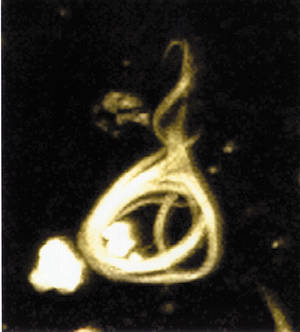A 'silver bullet' for Alzheimer's?
Interview with
A lot of focus has been on blitzing these amyloid plaques and there is now a push to target tau tangles but what if we could find a 'silver bullet' which could stop these proteins forming a sticky mess in the first place? Rosie Freer published a paper in Science Advances this summer that was looking at why some areas of the brain are resistant to build ups, whilst others aren't. And in this, holds a clue into this 'silver bullet', as she explained to Kat Arney...
to target tau tangles but what if we could find a 'silver bullet' which could stop these proteins forming a sticky mess in the first place? Rosie Freer published a paper in Science Advances this summer that was looking at why some areas of the brain are resistant to build ups, whilst others aren't. And in this, holds a clue into this 'silver bullet', as she explained to Kat Arney...
Rosie - We know that the hippocampus is one of the most vulnerable tissues to Alzheimer's disease. And what we also know is Alzheimer's spreads in a very specific spatial temporal pattern through the brain and there are some tissues in our brain that will always be very resistant to the diseases. And, as you mentioned, what I wanted to understand was why some tissues were vulnerable and why others were resistant.
Kat - So it seems to have this route that it likes to take from the hippocampus around different bits of the brain?
Rosie - Exactly. And what I did, I looked at the protein composition of tissues that were vulnerable and those that were resistant, and I identified a set of proteins that characterised vulnerable tissues and were able to predict the progression of Alzheimer's disease through the brain.
Kat - So there's certain characteristics then that make it more easy for these tangles, these plaques to form?
Rosie - Exactly. So if you look at a vulnerable tissue you'll see very high levels of the proteins which promote the aggregation of these plaques and tangles, and you'll see very low levels of the proteins that protect against this clumping process.
Kat - This isn't completely surprising to me because, obviously, different bits of the brain do different things but, was it a surprise to find these particular proteins seem to be in different levels in different parts of the brain, and does that seem to then tip when Alzheimer's kicks off?
Rosie - I think the interesting thing about these results - you're right. I think we would expect to see different levels of proteins in different regions of the brain because different regions of the brain have different functions. But the interesting thing about the results is they suggest there's an underlying biophysical basis to the disease. And they also suggest that there's a wider network of proteins which are responsible for vulnerability to disease beyond amyloid-beta and tau.
Kat - And is this just Alzheimer's where this is important? I mean there's lots of different types of dementia; there's lots of diseases that affect nerve cells; I'm thinking of things like Parkinson's or Motor Neuron disease.
Rosie - This is the really interesting thing about our results is if our hypothesis is correct, then we should be able to apply our results to other neurodegenerative diseases associated with aggregations such as: ALS, frontotemporal dementia, and be able to detect similar signals which define vulnerability to those diseases.
Kat - Okay. Put it all together: we've found that tipping the scales, tipping the balance of proteins in the brain is the problem; if we can find a way to tip it back then that could lead to a new treatment. How do we go forward from here?
Rosie - I think one promising approach that's been suggested by our results as well as may other studies would be to enhance the natural capabilities of our cells - it's called the protein homeostasis system - and create an environment which is really resistant to the type of clumping process that results in plaques and tangles.
Kat - It feels like it's just coming at it from a different angle, instead of focusing on the molecules, you're focusing on the process?
Rosie - Exactly, yeah.
Kat - And in terms of the treatments, are we still talking about something that's five, ten years away or is it even to early to talk about that?
Rosie - That's the golden question, isn't it?
Kat - It's almost like how long is a piece of string?
Rosie - Exactly, exactly. I think we're making great steps at the moment towards understanding the disease, and I think that will be the key to finding an effective treatment, and so I think it is on the horizon.










Comments
Add a comment